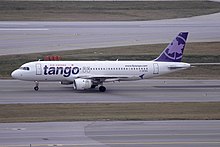This is an old revision of this page, as edited by H-Man Havoc (talk | contribs) at 15:26, 29 April 2014 (changed to match what it states in the article below; reinforced by a flight I had in 2004 to Orlando on an Air Canada Tango A320.). The present address (URL) is a permanent link to this revision, which may differ significantly from the current revision.
Revision as of 15:26, 29 April 2014 by H-Man Havoc (talk | contribs) (changed to match what it states in the article below; reinforced by a flight I had in 2004 to Orlando on an Air Canada Tango A320.)(diff) ← Previous revision | Latest revision (diff) | Newer revision → (diff)| This article possibly contains original research. Please improve it by verifying the claims made and adding inline citations. Statements consisting only of original research should be removed. (October 2010) (Learn how and when to remove this message) |
| This article needs additional citations for verification. Please help improve this article by adding citations to reliable sources. Unsourced material may be challenged and removed. Find sources: "Air Canada Tango" – news · newspapers · books · scholar · JSTOR (October 2010) (Learn how and when to remove this message) |
 | |||||||
| |||||||
| Founded | 2001 | ||||||
|---|---|---|---|---|---|---|---|
| Ceased operations | 2004 | ||||||
| Parent company | Air Canada | ||||||
| Headquarters | Montreal, Quebec | ||||||
| Website | Flytango.com | ||||||
Air Canada Tango was a low-cost subsidiary branch of Air Canada, which was established in 2001 to offer no-frills service on some of Air Canada's routes and to reduce operating costs at the struggling main company. Based in Toronto, Tango operated on the major longer-distance Canadian routes between cities such as Toronto, Ottawa, Montreal, Calgary and Vancouver, as well as to some holiday destinations in the USA and Mexico such as Fort Lauderdale, Tampa and Mexico City.
The airline's name is short for "Tan and Go", which is in reference to the southern winter destinations that were initially planned to be served.
After the Tango subsidiary folded in 2004, Air Canada retained "Tango" as a brand name for a type of fare on offer in its price structure.
Fleet


The fleet of Air Canada Tango consisted of up to 13 Airbus A320 and (from 2002) up to 6 Boeing 737-200.
Air Canada Tango aircraft were configured in a full economy class layout rather than with a business class section as on regular Air Canada aircraft and featured a distinctive purple colour scheme.
References
External links
- Official website at the Wayback Machine